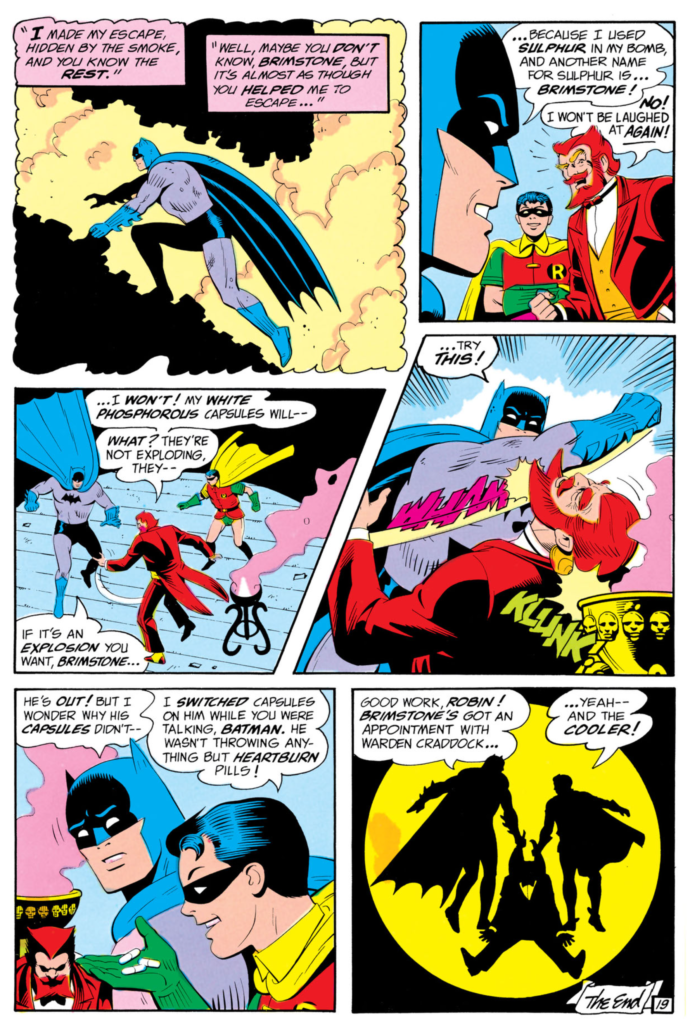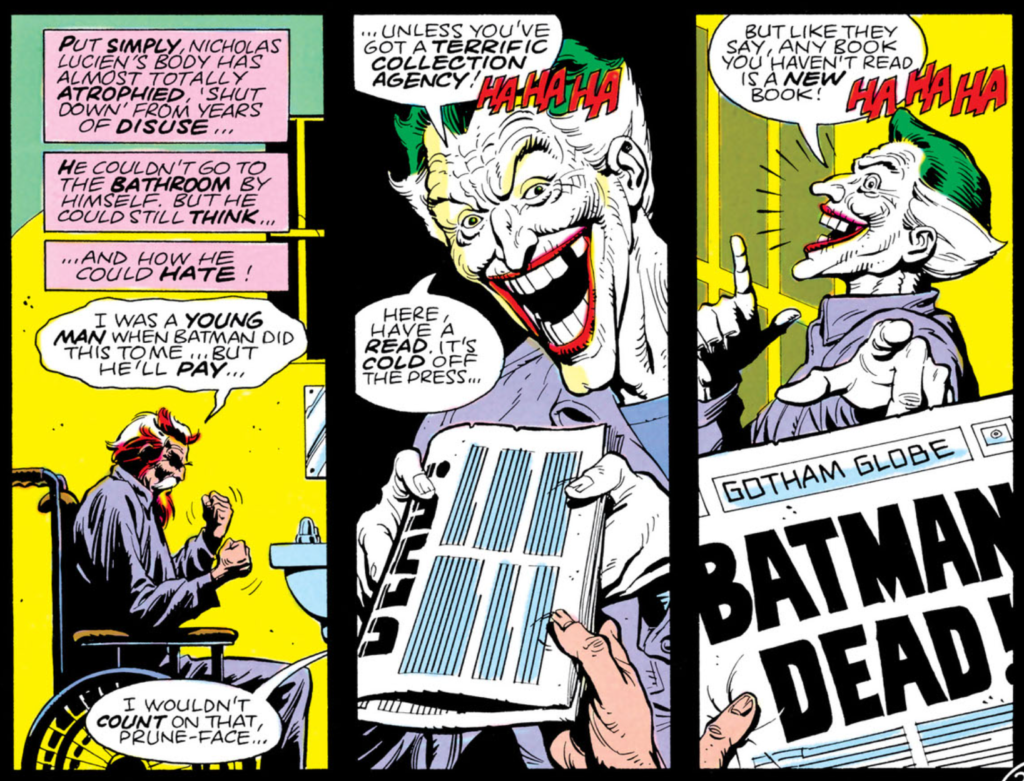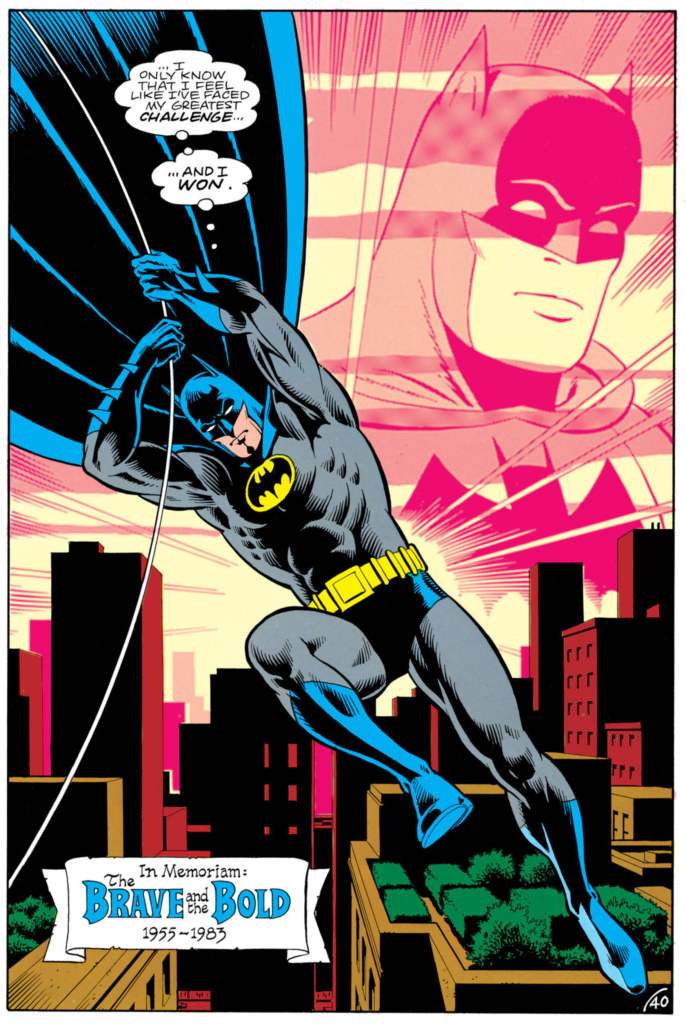Unbagging The Brave And The Bold #200
The Brave and the Bold, Vol. 1
#200A

Release: Apr 21, 1983
Cover: Jul 1983

Creators
| Writer | Mike W. Barr |
| Artist | Jim Aparo |
| Penciller | Dave Gibbons |
| Inker | Gary Martin |
| Colorist | Adrienne Roy |
| Letterer | Dave Gibbons | Jim Aparo | Gaspar Saladino |
| Cover Artist | Jim Aparo |
| Editor | Len Wein |
Again he’s thwarted me! I’m as cunning as Satan himself, yet again he’s thwarted me!
The Brave and the Bold is a title with a long and significant pedigree at DC. It was the series that introduced us to the original Suicide Squad, the Teen Titans, and a little-known group called the Justice League of America.
Though the series ended in 1983 – with this issue – the name has been revived multiple times, even breaking out of the confines of comics and into the world of animation. It was revived for a limited series in 2018 and has been revived yet again as of this writing.
While its focus varied for years, by the time I started reading it and up until its cancellation it was a Batman team-up book.
During this time period, DC had another team-up book, one that paired up the other half of the World’s Finest team with a new guest-star every month, in the form of DC Comics Presents, featuring Superman.
A bit before this issue came out, there was a DC Comics Presents annual that had the same basic premise, teaming up Superman and Superman. This comic – by necessity – takes a very different approach, and you can’t really call it a team-up.
Instead of working together to defeat a common enemy, the two Dark Knight Detectives separately face off against the same opponent – kind of – on different worlds and in different decades without ever encountering each other.
Our story begins with a prologue explaining a bit about the DC Multiverse, telling us about two worlds that are similar but distinct, giving us a side-by-side shot of Jay Garrick and Alan Scott, the “Golden Age” Flash and Green Lantern of Earth-Two, and Hal Jordan and Barry Allen, the “Silver Age” – though by this time we were in the Bronze Age of Comics – Green Lantern and Flash of Earth-One.
The part that’s most important to our story is that on both worlds a baby is named Nicholas Lucien is born on the same day, and while they share the same name and appearance, the two grow up to be very different men, but throughout their lives they each feel as if they’re not alone, as if they have some twin out there. Somewhere.
The Nicholas of Earth-Two pursues a life of crime, while the Nicholas of Earth-One achieves success in life as a legitimate businessman.
As an aside, it’s an interesting change here, as much of the time when versions of the same person exist on both Earth-One and Earth-Two, the Earth-One version is born much later. For example, the Earth-One Bruce Wayne was born decades after the Earth-Two Bruce Wayne.
(The Earths are named that way because Barry Allen was the first person to travel from one Earth to the other and as a result got to do the naming.)
The story proper initially focuses on the Nicholas of Earth-Two, in 1955, who commits his criminal acts under the nom de crime of Brimstone.
Unfortunately, the devil-themed villain doesn’t exactly instill the fear of damnation in the hearts of men.

It seems that Brimstone’s reputation suffered considerably after he faced off against Batman and Robin and ended up in prison, and while he is a free man once more, no one is interested in his attempts at starting a new gang.
After giving them the ol’ razzle-dazzle (throwing explosive phosphorus pellets at them), Brimstone gets the two hoods to change their tune and the agree to join up with him.
He starts his crime comeback the way any self-respecting criminal in Gotham City would: by sending clues about the crimes he plans to commit to the Batman.
Each time, with the help of his young sidekick, Robin, Batman is able to foil Brimstone’s schemes, though Brimstone himself manages to get away each time.
Mostly via knocking Robin out.
After two thwartings, Brimstone decides he has to take things to the next level.

Towards that end, the next clue Brimstone provides is a gimme, something that isn’t even remotely challenging for the World’s Greatest Detective, and as a result, this time he’s fully prepared when the Dynamic Duo arrives, managing to capture Robin and force Batman to surrender.
Rather than just shooting the captive Caped Crusader, Brimstone chooses to go the old death trap route, taking his captives back to his abandoned meat-packing plant hideout and tossing Batman into a pit that will soon fill with molten lava.
Unfortunately for Brimstone, Batman is able to escape, having pilfered some of the potassium nitrate – used for preserving meat – that was lying around before being tossed into the pit, and using it and some of the other ingredients in the wall of the pit to make gunpowder, which he put into one of the lava-dispensing nozzles he removed, making a crude bomb that he could use to blast an escape tunnel for himself.

That closes the first part of our Batman and Batman adventure, and we move to an interlude in the present day (well, when the present day as 1983) at Gotham State Prison, where we learn that when he bonked his noggin after Batman punched him back in 1955, Nicholas Lucien has been in a coma for 28 years.
A doctor is visiting with a serum that she thinks will revive Lucien, who is horrified to discover that he’s now an old man, having spent the prime of his life unconscious thanks to the Batman.
Obviously, he wants revenge on Batman, but that can’t happen for the same reason that the two Batmen can’t directly team up.

At first, he’s dejected. The man he wants to kill is already dead.
But then he remembers that feeling that he’d had for his whole life, the feeling that he wasn’t alone. That there was another Nicholas Lucien out there somewhere.
And it stands to reason that if there’s another Nicholas, there might also be another Batman. And with that thought, his body lapses back into unconsciousness, though this time it doesn’t seem to be a simple coma.
No, warden, it’s almost as though his mind is…gone.
From there we move to Earth-One, home of the still-living, much younger Batman.
Things aren’t looking great in his Gotham. Someone is blowing up churches, synagogues, and cultural centers, and tensions are high, with people rioting in the streets demanding the capture of the mad bomber.
Naturally, Commissioner Gordon reaches out to the Batman for assistance.

Batman, being Batman, starts examining the clues and identifies traces of a very specific powder on the note, a powder that is only processed by a few laboratories in Gotham. The first on his list is owned by upstanding citizen Nicholas Lucien.
Upon investigating Lucien’s chemical plant – AKA breaking and entering – Batman is greeted by a bunch of thugs and a televised message from a man identifying himself as Brimstone who informs Batman that as part of their rematch Batman must defeat all of the thugs in order to find Brimstone’s location.
Batman is confused by the reference to a rematch, but soon makes short work of the thugs, managing to use them against each other, as they’re members of a street gang who are used to gang fights, not taking on one man.
Once they’re taken care of, he finds his clue and heads to what he believes to be Brimstone’s hideout, but he’s been duped, and the air spiked with the very powder that led him to Lucien in the first place, a powder that can be ground fine enough to get through any kind of nose filters and serves as a cardiac and respiratory depressant, causing Batman to fall into unconsciousness.
He comes to in a pit that is much like the one in which his predecessor found himself in the first story, though in that one Brimstone had a mirror positioned allow himself to see into the pit, whereas this time around he’s using a camera and a television to observe his foe’s death.
Oh, and meanwhile, there’s a “racial unity” special that’s going to broadcast live to help to ease tensions in Gotham, hosted by three of Gotham’s most prominent community leaders, and Brimstone’s going to blow that up.
He’s certain that Batman won’t escape in time to stop him from doing so, telling Batman that there are no minerals he can use to create gunpowder.
Batman remains confused about all of the “this time” talk but chooses to ignore him so that he can focus on escaping. Hist first step is making himself a little raft that he can float on by ripping off some of the lava-proof insulation on the wall of the pit.
Then we check in on Brimstone and see that Batman isn’t the only one fighting for his life.

Batman, of course, finds a way to escape that is just as explosive as his predecessor’s escape, and stops Brimstone from blowing up the studio, and as with the previous story, this one ends with Brimstone getting a serious bonk on the noggin.
However, this Nicholas Lucien doesn’t lapse into a coma, but instead comes to and acts as if he’s just come out of one.

In the epilogue we see that the Earth-Two Lucien has perfectly normal brain readings but is totally paralyzed and likely will be for the rest of his life, and the Earth-One Lucien “has passed the most sophisticated lie-detector tests” and is set free.
While Batman can’t say for certain if Lucien was possessed, that does certainly seem to have been the case, and he thinks it’s best that the man is free to return to his normal life. He thinks that he’ll never know for certain, what happened, but…

The issue closes out with a one-page Bat-Mite gag, and a preview of Batman and the Outsiders, the new comic that took the place of The Brave and the Bold on shelves and spinner racks.
This story finds Batman and a mysterious new team of mostly-new faces – plus the already-established Metamorpho the Element Man and Black Lightning – working to keep a terrorist organization from blowing up Gotham General Hospital.
(I just realized there are several connections – probably not deliberate – between this issue and 2008’s The Dark Knight.)
SpoIler Alert: The new team comes through and keeps (almost) everyone safe.
But there remains one question:

I ended up reading a lot of Batman and the Outsiders, up until it went direct sales only and became just The Outsiders. It was good, but I mainly wanted to focus on the two Batman stories. I always thought this was a clever way to have a team up featuring characters who weren’t actually able to team up.
(However, if this had been written by veteran The Brave and the Bold scribe Bob Haney instead of Mike W. Barr, the fact that one Batman was dead wouldn’t have stopped him from writing a story in which they team up directly. It wouldn’t have even been a consideration and would not have been addressed in any way in the story.)
I recently reacquired this issue – no idea what happened to my original copy – and was reminded of it on Twitter the other day, so I figured it was worth an Unbagging.
What I always appreciated about it was the way it managed to tell two distinct but connected stories that each had their own tone but managed to feel cohesive.
The first story with its humor and more lighthearted tone very much felt like something out of the 1950s -when I first read it 40 years ago I kind of thought it was a reprint – and the second, with its violent imagery, darker tone, and focus on contemporary topics, was very much a story from 1983.
Of course, much of the credit for that successful shifting of tones goes to Dave Gibbons who perfectly modified his style to bring to mind the work of Dick Sprang will still being uniquely his own. That’s what really provides the coherence that allows the two stories to combine so seamlessly. And Brimstone had a great design that was easily adapted to both eras.
It was fun to see the differences between the Golden Age Batman and the then-modern Batman and their Gothams, such as the portlier Commissioner Gordon in the Golden Age, the fact that Joker was locked away in an ordinary prison rather than Arkham Asylum, and the lack of gigantic version of everyday items in modern Gotham City compared to Golden Age Gotham.
The clues provided by both versions of Brimstone were clever, and I especially appreciated that there was a double meaning to the simple clue that Golden Age Brimstone provided after he decided to kill Batman – the clue led Batman and Robin to a bait shop, complete with a giant fishing rod on display, and that clue was bait for a trap.
I liked the concept of Brimstone’s hatred being so powerful that it could bridge the gap between worlds and allow him to assert control over his other self, making him a prisoner in his own body in much the same way that the Earth-Two Lucien had been for so long and was once again as the story ended.
And, of course, there was the indirect way in which Batman and Batman teamed up, with the Golden Age Batman indirectly saving the modern Batman’s life, as Brimstone mentioning the other Batman’s use of gunpowder inspired the modern Batman to come up with his own explosive means of escape. One man reaching out across time and space to save his other self through a man who was destroying his other self.
It’s just a couple of fun stories with a neat connection to each other, so I thought it was worth talking about.

Born and raised in the sparsely populated Upper Peninsula of Michigan, Jon Maki developed an enduring love for comics at an early age.


